The Bernedoodle: A Modern Dog That’s For You! Bernedoodles are smart dogs with an easygoing temperament. They get along well in different living spaces; whether it be in your home or out on nature trails.
The Bernedoodle is an ever-increasingly popular breed of dog.Bernedoodles have made their mark on many families all over the world with their intelligence, temperament and size.

Have you been contemplating getting a new dog for your family? If you’re looking for a dog that’s friendly, easy to train, and low-maintenance, then the Bernedoodle is the perfect pup for you.

What Is A Bernedoodle?
The bernedoodle is a product of two different breeds: the Bernese Mountain Dog and Poodle. The Bernese mountain dog originated in Switzerland, but it was bred to be used as an all-around working dog. They have also been popular for being family companions because they are friendly dogs with mild dispositions that get along well in most living spaces.
Poodles on the other hand come from Germany or France where they were initially meant to hunt waterfowl. It wasn’t until later when poodles became more domesticated and known as house pets due their intelligence, good temperament, size and appearance!
These furry friends have now taken over many homes across the world too thanks to how easygoing they can be and how low-maintenance.

And that’s what a bernedoodle is! They have the intelligence, temperament and size of their Bernese mountain dog parents as well as appearance thanks to their poodle parentage. Curious about whether you should get one?
Read on for more information about this pup or if you already know all there is to know, read on with me so I can show you how to go out and find a new furry friend today!
History Of The Bernedoodle
Many people are familiar with the Bernese Mountain dog- a large, gentle giant that is often seen guarding Swiss farms and homes. The Poodle also has quite an extensive history of its own as well; originally bred to be used in hunting waterfowl such as ducks and geese.
Eventually they became popular for their intelligence and loyalty, making them great family dogs! Modern day Bernedoodles owe their origins to a cross between these two :Bernese Mountain Dog and the Poodle, two very different breeds.
Historically speaking, one of the first breeders to mix these two was Sherry Rupke . She decided that she wanted to try out her theory of what would happen if you bred a giant working dog with an intelligent low-shedding companion dog!

So now we have this amazing hybrid creature called a “Berndoodle”! The modern definition includes any breeding done by crossing a Bernese Mountain Dog with any other poodles.
The breeds that make up this cutie have their own unique qualities, which are passed on to the dog’s puppies. The result of breeding these two dogs together creates an intelligent dog with a sweet disposition; purrfect for any family!

How Is The Temperament Of Bernedoodles?
Bernedoodles are surprisingly easy to train, and they’re very intelligent. They have a delightful disposition which makes them the perfect family dog for any home!
A Bernedoodle’s temperament is friendly and loyal- something you’ll want in your new furry friend.
The cross between these two breeds will result in an outgoing pup with a mild demeanor that loves children and other pets.
Bernedoodles have an easy-going temperament. They are happy to live in a variety of different living spaces; whether it be your home or on nature trails.

Their intelligence and size make them great for people who want to explore the outdoors with their dog, but they will also do well as couch potatoes too!
A Bernedoodle is especially suited for families that may not always be able to give their dogs all the attention they deserve due to work commitments etc.
They also tend towards being more sensitive than many other breeds, so if you’re looking for a friendlier companion then this pup might just suit you perfectly!

What Are The Different Sizes Of Bernedoodles?
One of the most important things to think about when considering adopting a bernedoodle is size.
When fully grown, it’s safe to say that these dogs will be a certain height and weight—which would need to work in your home space. Certain sizes are suitable for certain families and the best part about bernedoodles is that they come in variety of sizes.No matter what your requirements are, you will find a bernedoodle that fits into your arms !
There are 4 different bernedoodle sizes-
1.Tiny/Toy Bernedoodle
2.Mini Bernedoodle
3.Medium Bernedoodle
4.Standard Bernedoodle

What Is A Tiny Bernedoodle ?
A tiny bernedoodle is a result of breeding Tiny/toy Poodle with a Bernese mountain dog. They are around 12 to 15 inches in height and can have weight ranges from 10 to 25 pounds at the time of full growth.
The best part about these pups is they can stay little forever with well-balanced diet and consistent exercise !
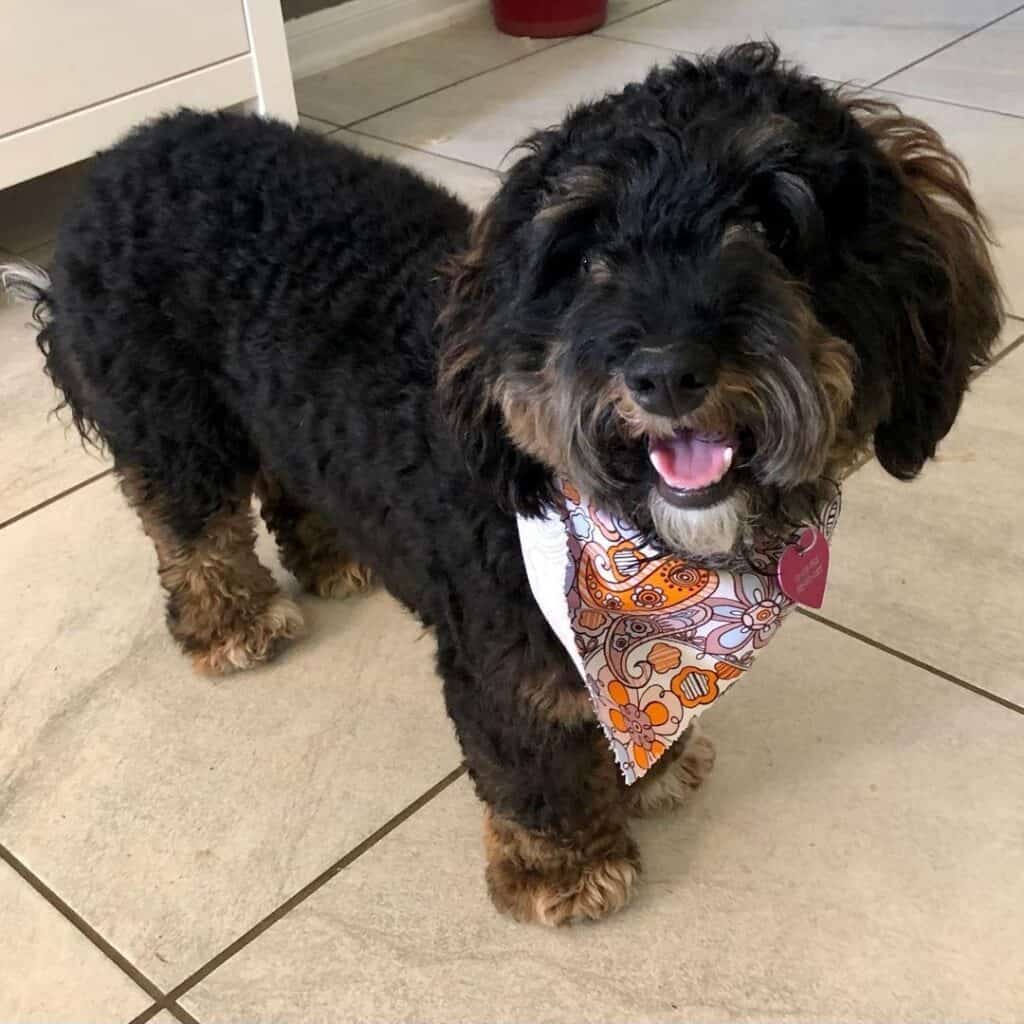
Who Should Opt For Tiny Bernedoodles?
These adorable furballs make great companions for college students who don’t want their roommate’s rat dragging across the room when it ventures out from under the bed.
These dogs are perfect for those that live in small apartments, condos or studios and have limited space or want a cuddly lap puppy!They may take up less space but they still bring plenty of love into your life!
What Is A Mini Bernedoodle?
The mini bernedoodle is the result of breeding Mini Poodles with Bernese Mountain Dog. They are around 15 to 18 inches in height and can have weight ranges from 25-35 pounds at the time of full growth. Though they are called mini bernedoodles they are more like a medium weight category.
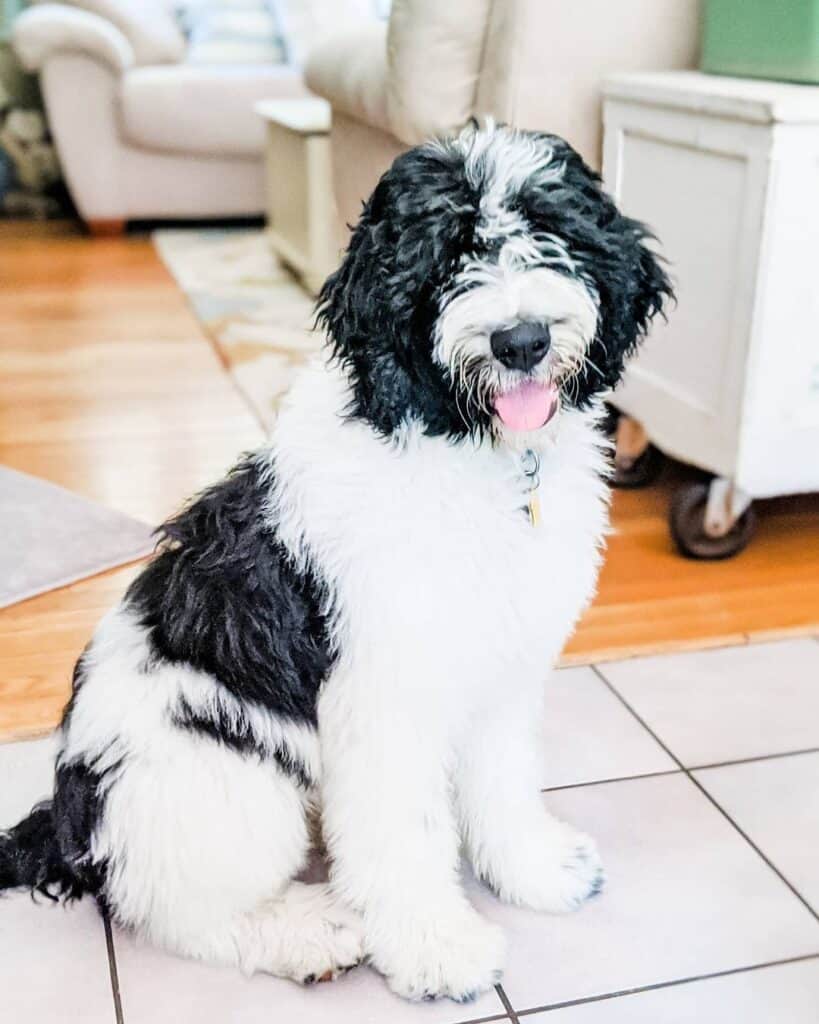
Who Should Opt For Mini Bernedoodles?
These lovable mutts make great companions for families with small children who want a companion that will be able to keep up! With their medium energy levels, they’re perfect for those living in an apartment or someone looking into getting a second dog!
These dogs require less maintenance then others as they shed very rarely, meaning long walks on the beach isn’t necessary !
What Is A Medium Bernedoodle?
Medium bernedoodles are the result of breeding Medium Poodle with Bernese Mountain Dog. They are around 18 to 24 inches in height and can have weight ranges from 35-55 pounds at the time of full growth.

Who Should Opt For Medium Bernedoodles?
Medium sized bernedoodles are the perfect option for those that like a little more responsibility! They’re great for people who have a medium to large family, or live in an apartment with a yard but want some company.
This size is also good for working dog owners looking into getting their first puppy! Medium Bernedoodles require lots of exercise and grooming !
Medium bernedoodles make perfect companions for families with children and adults! They are a great size to all be in the same picture together, without being too overwhelming.
What Is A Standard Bernedoodle?
Standard bernedoodles are the result of breeding Standard Poodle with Bernese Mountain Dog. This is the largest size variety of bernedoodles.They are around 28 to 30 inches in height and can have weight ranges from 55-90 pounds at the time of full growth.
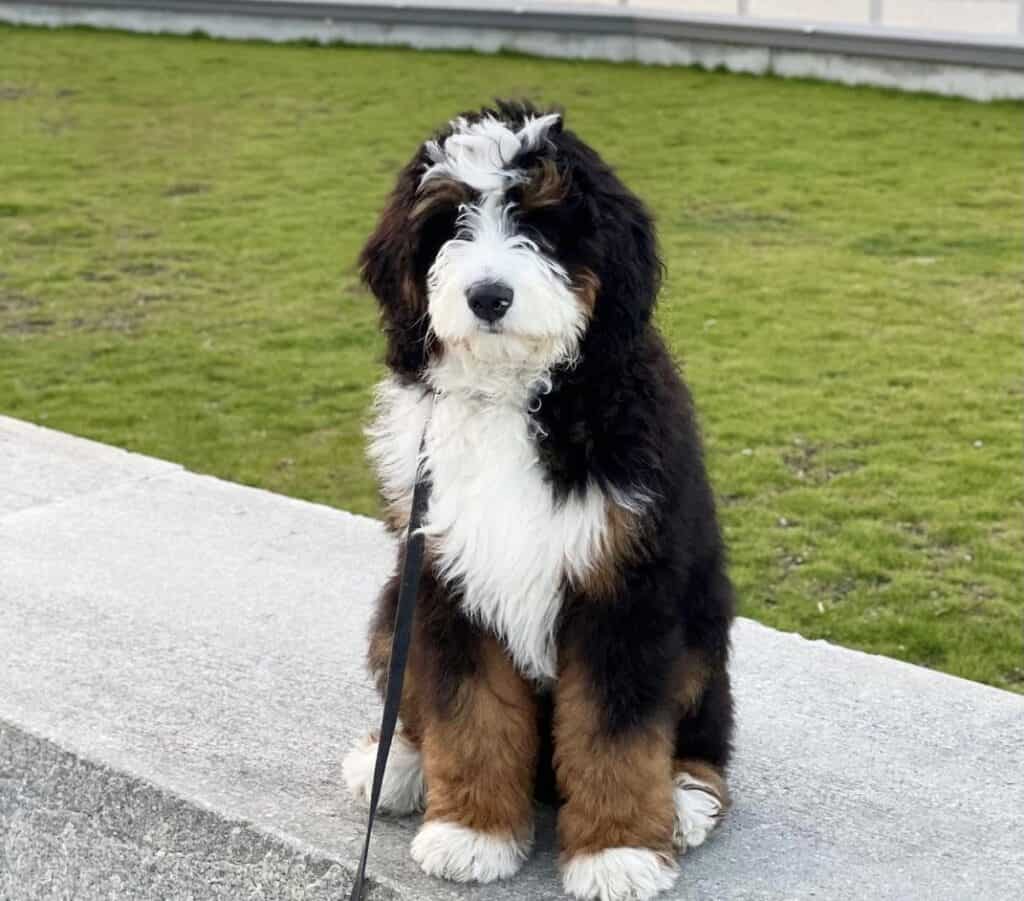
Who Should Opt For A Standard Size Berndoodle?
If you’re looking for a dog that is going to be big, but not too big, then this size is perfect for you! These dogs require lots of grooming and exercise so they stay healthy ! Great for families with older children or multiple adults as well!
This medium to large sized pup will fit into most homes just fine without being overwhelming like some other breeds would be. Have your kids ever asked if they could bring their friend home but you don’t want a puppy too big? This is the perfect size for that!
Which Size Bernedoodle Is Right For Me?
The best way to find your answer is by looking at what’s important in your life.
If space and budget are an issue, then go with Tiny bernedoodles !
If you have children or want companionship from day one, try out Mini bernedoodles!
Medium sized pups will be great if you’re living on a medium sized property and can still walk them regularly-they just need more grooming than other sizes do.
And finally Standard Bernedoodles are the right choice for those of who love your pets as part of the family and live in big properties where they’ll get plenty of exercise .

Bernedoodle Colors: What Do Bernedoodles Look Like?
Bernedoodles are a very unique looking dog, with coats that can be straight or curly. They have long tails and legs to go with their round faces, which is where the Poodle comes in! Their tails will often curl over their back when relaxed as well.
You might not think so from looking at them but Bernedoodles come in different shapes and sizes ! But no matter what color coat he has,he’ll always be wonderful and lovable because of his sweet personality!
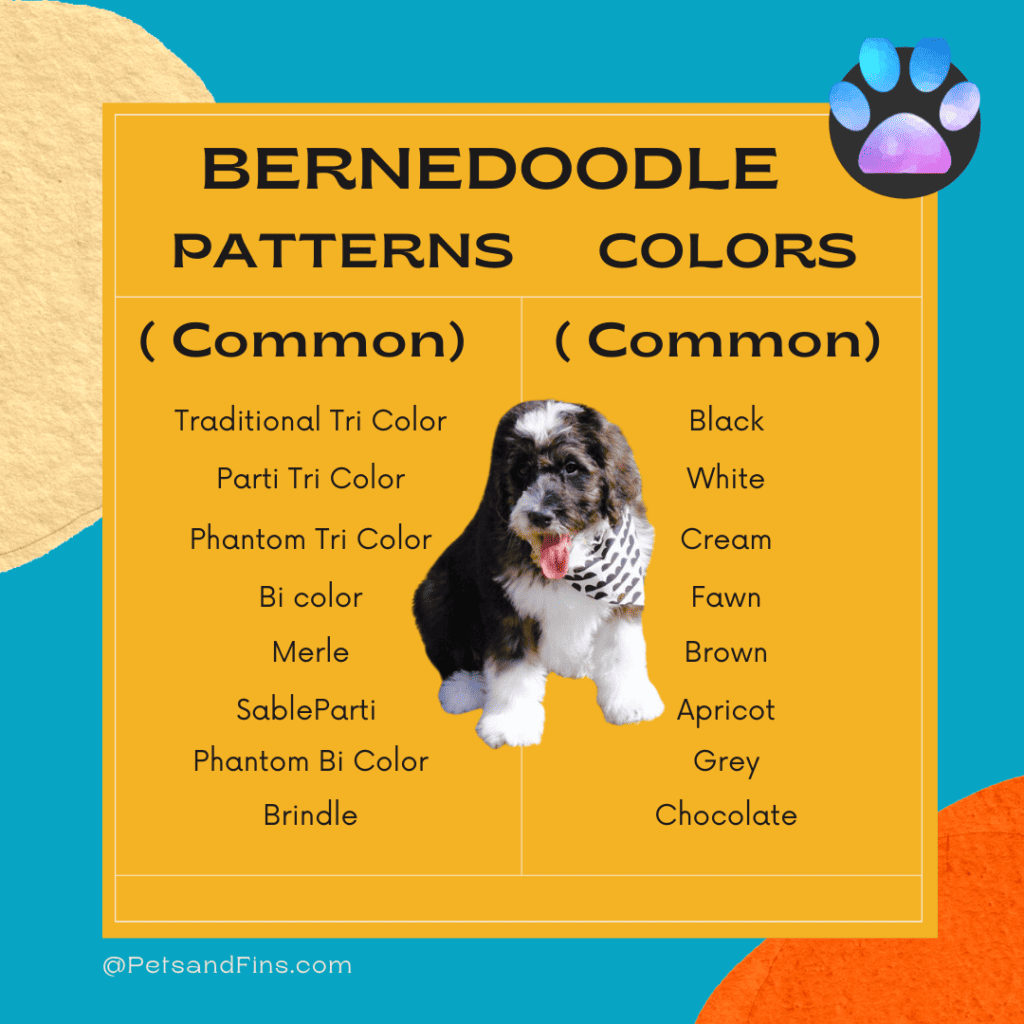
If it’s the color of his fur you’re looking for, then he might be a black bernedoodle or brown bernedoodle. The best thing about these furry friends is that they come in variety of colors: like black and tan; brindle and white; chocolate colored with tan markings on their body.
What Does A Bernedoodle’s Coat Look Like?
The coat of a bernedoodle varies on how much poodle is in them and whether it’s curly or not . For example, if you were able to see through all three layers of this fur then you’d notice the outermost layer being course like your standard doodle. The second layer would be soft like the poodle fur, with this third and final layer being curly.
A bernedoodles coat can also sometimes feature a mix of colors! Some are solid brown while others have speckled spots that make them appear black or white in certain lighting.
These dogs come in many different colors such as chocolate brown; cream-colored ,with dark tan markings on their body.There is also the occasional red/brown mix that can happen depending on which breed contributes more to the puppies genetics.
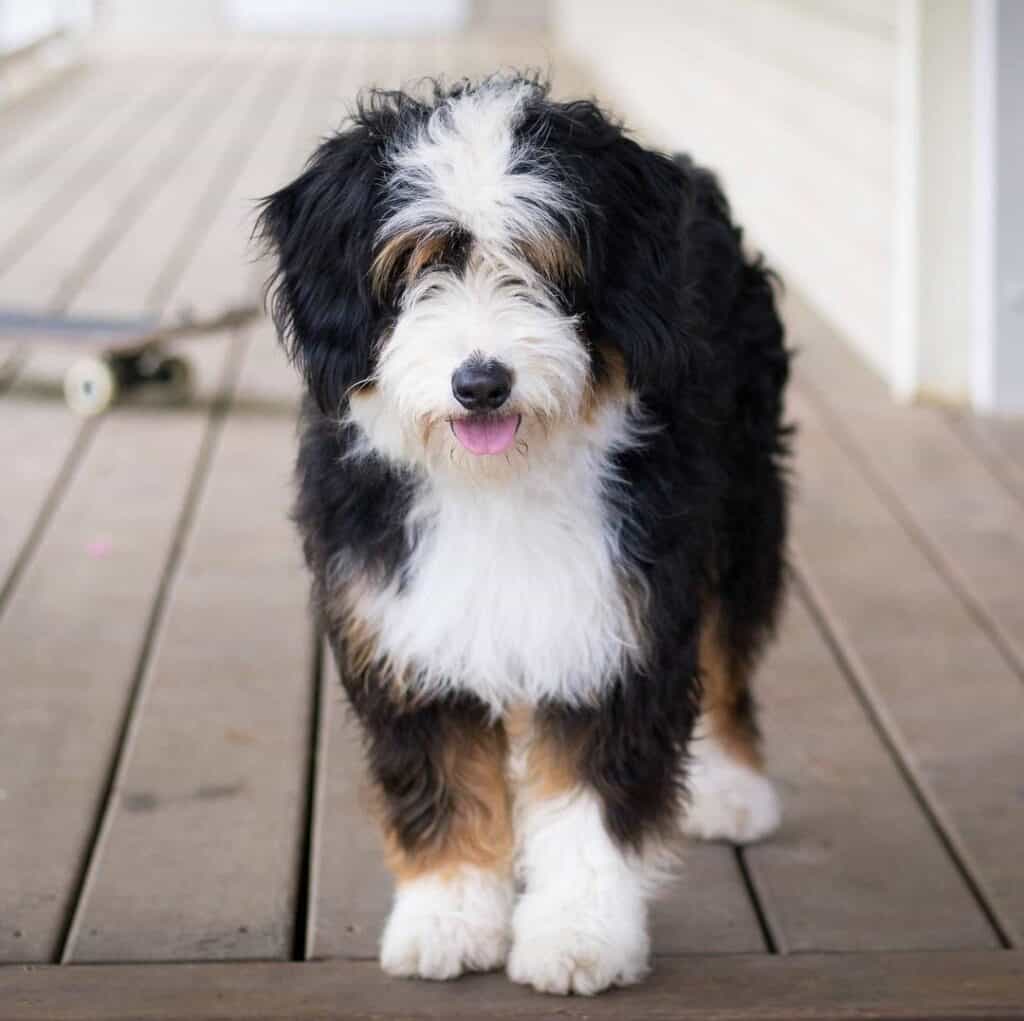
What Coat Texture Do Bernedoodles Have?
The bernedoodle can either be a Poodle mix or a Mountain dog mix: this will determine what kind of texture their hair has. If it’s curly like the poodle then they are considered to have “woolier” textured hair; if it is more straight-haired like the mountain dog, then they’ll have “smoother” (but still sometimes fuzzy) textured hair .
These dogs also occasionally grow some longer hair on their muzzle which makes them look like they’re wearing a beard!
What are the F1,F1B,F2 and F2B generations of Bernedoodles?
F1 generation Bernedoodles are a first generation cross, where the puppies are 50% Bernese mountain dog and 50% poodle, genetically.
F1 b generation bernedoodles are a first generation cross , where the puppies are 25% Bernese mountain dog and 75% poodle, genetically.
F2 generation bernedoodles are a second generation Cross, where the puppies are the result of breeding between two F1 Bernedoodles.
F2B Bernedoodles are also called as Teddy bear Bernedoodles and they are a second generation back cross that is produced by breeding an F1 Bernedoodle with an F1B

What Is The Right Diet For Bernedoodles?
Bernedoodles, just like any other dog, needs to be fed a well-balanced diet. A Bernedoodle’s diet should consist of high amounts protein (usually meat) and low carbohydrates; fruits/vegetables may be included as well but this will depend on if you want to feed your pup 100% raw food or not.
Feeding your pup a raw diet is the best option because it provides them with everything their body needs and eliminates some of the drawbacks that come with commercial kibble.
Dogs on an all-raw diet are less likely to get skin issues, they have cleaner teeth which means no need for dental cleanings or tooth brushing, and smaller stools!
Feeding your dog fresh food also helps keep him healthy by lowering his chances of developing allergies from artificial preservatives in commercial brands.

Bernedoodle Puppies should be weaned from their mother’s milk and transitioned to solid food by around 3 to 4 weeks of age.The best way to start them off with meat is to use plain, raw, boneless white meats such as chicken,fish and turkey.
Around four to five weeks old, these puppies can transition onto red meat minces such as duck, beef, pork, and other organ meats.
These puppies can soon be moved onto meat on the bone by around six weeks of age.Bernedoodles have very sensitive stomachs, which means they need to eat the right kind of foods on a consistent basis.
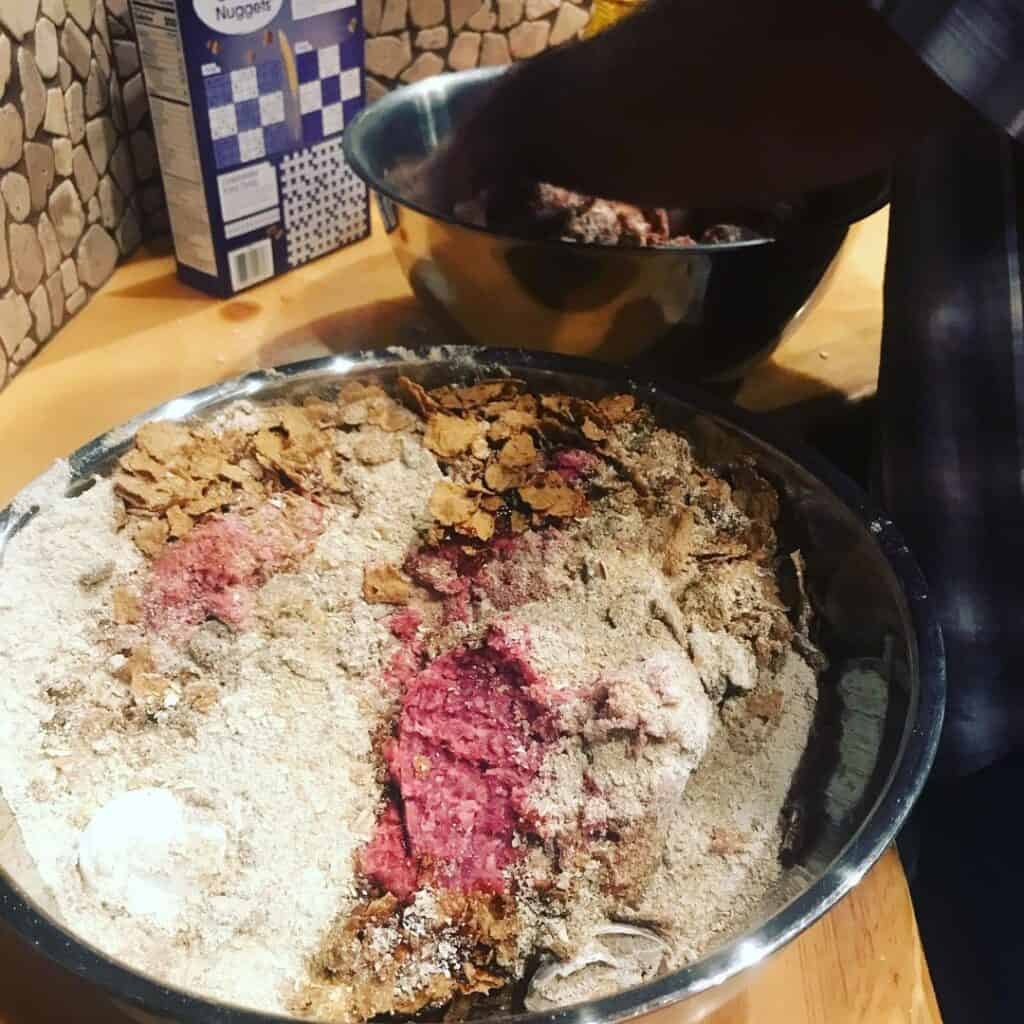
Commercial Food For Bernadoodles : In case you want to opt in for a commercial brand of ready made puppy food ,you can include dry kibble with wet canned food as an occasional treat. They need protein, carbohydrates and their vitamins and minerals daily.
The ideal commercial food food for your bernedoodle is one with all these nutrients included in the first five ingredients listed on the package!
The most common mistake people make is not reading ingredients carefully when shopping for a new bag of kibble.
It can be easy to get distracted by flashy labels or good marketing campaigns; however this often leads us into buying foods that are full of artificial colorings, additives and preservatives such as corn syrup solids, soybean meal, animal fat preserved with BHA (butylated hydroxyanisole) or propylene glycol among others!
This list is only scratching the surface too- there are many more potentially harmful ingredients in dry food that can lead to health problems and illness.
An easy way to avoid these potential risks is by buying a bag of specially made dog food called “veterinarian approved” or “vet recommended”. These foods aren’t full of fillers, preservatives, dyes or other things you don’t want your pup eating!
How Much Food Should You Feed Your Bernadoodle?
The amount of food that your bernadoodle eats will depend on its size, age and activity level. Ideally you should feed it three to four times a day according to the schedule below:
Suggested Feeding Schedule For Bernedoodles
Puppy ( under 12 months old) :
Breakfast : Half cup kibble + one can wet food
Lunch : Half Cup Kibble + One can wet food.
Dinner : Half Cup Kibble + One can wet food
Adult Bernedoodle ( over 12 months old):
Breakfast: One cup dry kibble + two tablespoons canned food with meat or minced cooked chicken.
Lunch : One cup dry kibble + two tablespoons canned food with meat or minced cooked chicken.
Dinner: One cup dry kibble + two tablespoons canned food with meat or minced cooked chicken.
Senior Bernedoodle:
Breakfast: A half cup dry kibble + one tablespoon wet food+one teaspoon fish oil capsule OR vitamin E supplement.
Lunch : A half cup dry kibble + one tablespoon wet food+one teaspoon fish oil capsule OR vitamin E supplement.
Dinner:A half cup dry kibble + one tablespoon wet food+one teaspoon fish oil capsule OR vitamin E supplement.
Another good guideline is the “divide by four” rule, which states that dogs need one cup of dry kibble for every 20 pounds (or 40 kgs) of body weight per day.
This varies from dog-to-dog though; some may require more or less than this amount based on activity level, metabolism, hereditary factors etc.
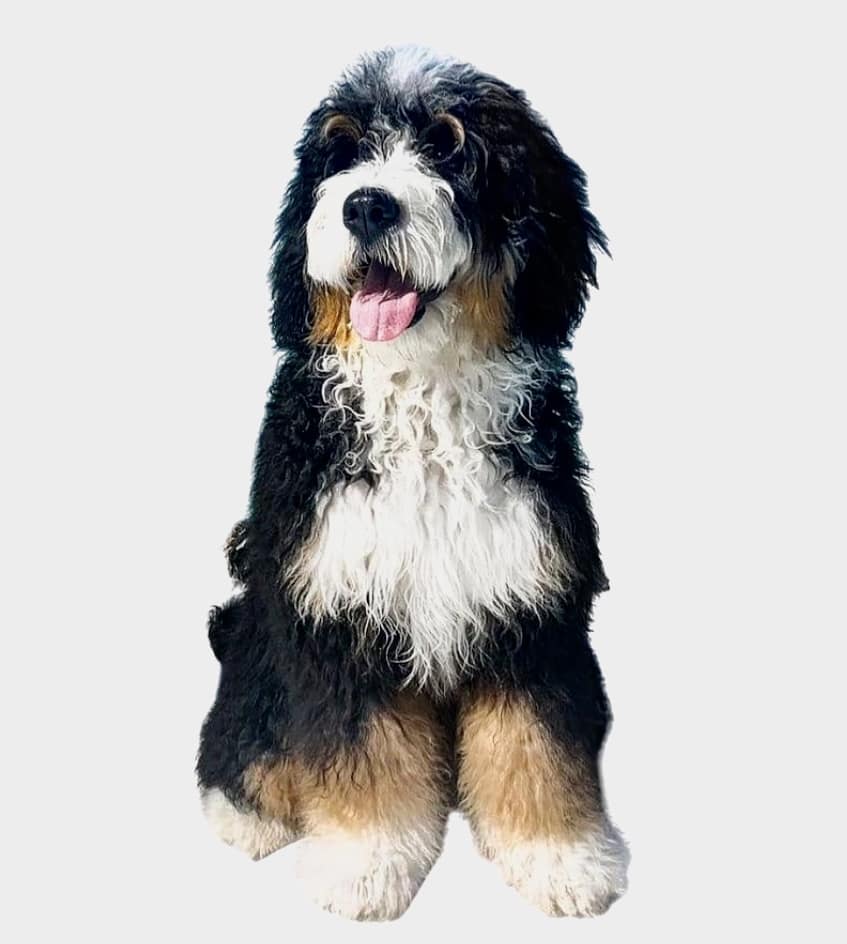
It’s also important not exceeding feeding guidelines because if left unchecked this could lead to obesity or other health problems such as pancreatitis, diabetes, and even kidney disease.
Bonus Tip : If your bernedoodle shows signs of having skin issues (like excessive shedding) then you may need to increase their omega fatty acid intake with salmon oil! This will help them process the new proteins they are consuming from meat products as opposed to soy or wheat which can cause more problems for dogs with this issue.
Fun Fact : Bernedoodles have been known to go through periods where they act like puppies again; eating more frequently or snacking throughout the day in order to maintain their playful energy! Isn’t that adorable ?

How Much Exercise Do Bernedoodles Need And How Often To Take Them On Walks?
Once a bernedoodle has reached three months of age, they should be able to walk for at least thirty minutes every day. If it’s not possible for you to take your pup out on walks then try giving them chew toys or other interactive items that will keep their mind and body active.
Bernedoodles are intelligent and need mental stimulation to keep them from becoming bored and destructive. They are also happy dogs who love people, so they can be easy going in the house as long as you take care of their needs!

A Bernadoodle needs a lot of exercise to stay fit and healthy. They have very high energy levels, so it is best for them to be walked at least three times per day- in the morning, afternoon and evening. It’s important not only because they need their daily dose of playtime but also because this helps burn off any excess energy and maintain their muscle mass.
Some owners also like to take this opportunity to train their pup during these walks, by teaching them new tricks or commands!
This is a great idea for anyone who wants an obedient dog; the more you practice the better your pup will be at following orders. Dog training not only helps create a well-behaved pup, but it also helps build a bond between you and your dog.
Suggested Exercise Schedule :
–Young Bernedoodle (under 12 months old): One hour of exercise per day to keep them from getting too bored or restless.
–Adult bernadoodle: Two hours per day may be required for that daily walk and some playtime; however this will depend on your Dog’s size, age, and activity level.
–Senior bernedoodle: Increased supervision is key as they are more prone to injury when their joints start aching! If you do decide to take them for a long walk try not going up any steep inclines or stairs if possible. You can also alternate between periods of walking and resting in order to avoid adding undue stress on your senior friend’s body!
Suggested Walking Schedule :
–Puppy ( under 12 months old): Two walks a day with at least 15 minutes each
–Adult Bernedoodle : Atleast One walk of 30 minutes, everyday.
–Senior Bernedoodle : A shorter walk as needed to maintain the dog’s weight and provide exercise for its joints.
They also need additional stimulation and mental activities such as running around or playing fetch so they don’t become bored easily! It’s also good to get them used to different surfaces like dirt, sand, grass etc., which can even make car trips more enjoyable.

Bernedoodles can also enjoy dog parks with their friends, as well as swimming and playing fetch- just like any other pup would want!
You should always make sure that you do not overdo it though; these little guys have short noses which makes them susceptible to breathing problems when they get too hot from all of this activity on top of being overweight due to overeating. It’s best to take things slow until you know what is appropriate for your Bernedoodle.

How Frequently You Should Bathe Your Bernedoodle ?
–Puppy (under 12 months old): Bathe once every few weeks, or as needed.
–Adult Bernedoodle: Once a week is enough unless you are showing them at an event where they may need to be bathed more frequently in order to keep their coat looking great!
–Senior Bernedoodle: It’s suggested that you brush their hair about two times per day, every other day in order to maintain the dog’s coat without any excess shedding!
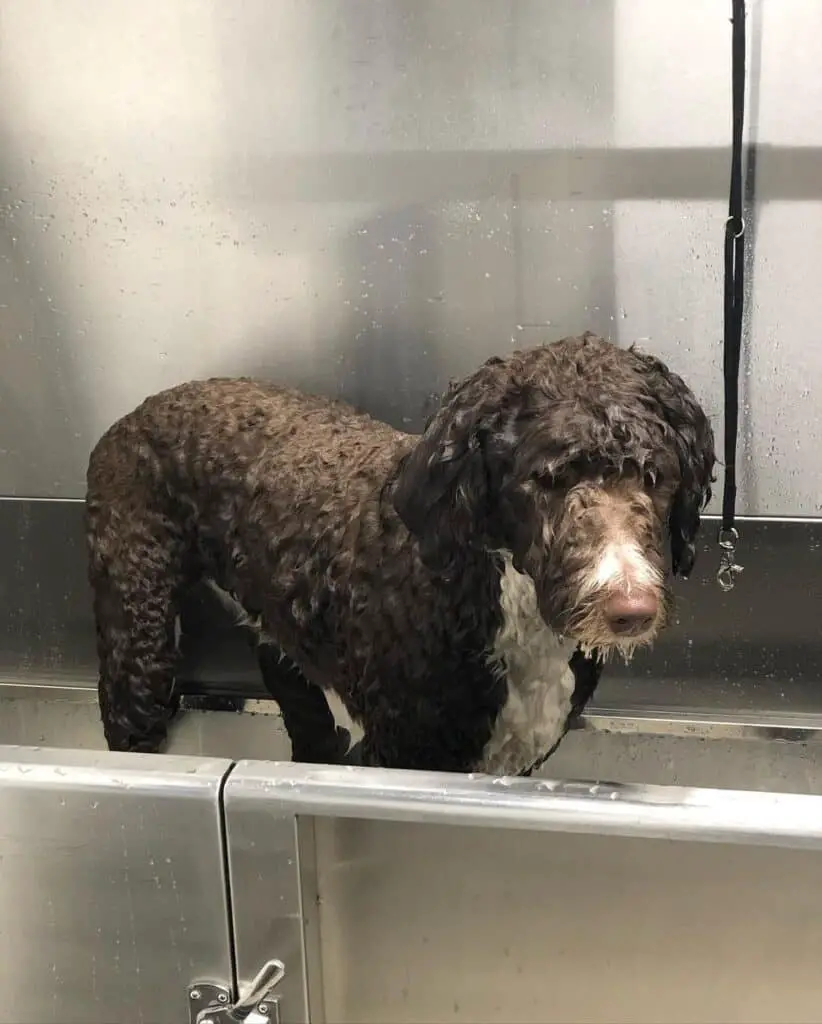
You should also bathe your senior friend once a month or when they start looking particularly scruffy from all of their activities. You can use shampoo on them again but make sure it is for dogs only; many human shampoos contain soaps which will dry out the natural oils coming from the bernadoodles skin.
Be careful not to get soap into his/her eyes either–you never know what kind of allergic reaction this could cause! And please be mindful of how long you leave them wet as this can lead to skin issues.
You should also take a look at your dog’s fur and watch for any signs of scratching, or raised patches on the skin. If you find this is happening, then it might be time to hop in the tub!
You should put some shampoo onto their coat massaging it into his/her hair but make sure that they don’t have soap residues which could cause dryness; rinse thoroughly before toweling them off with a soft towel–remember not to leave them wet for too long because this can lead to other problems such as infection.
Once out of the bath: always pat him/her down rather than brushing if possible so he doesn’t get cold from being dried by an air conditioner (or vice versa), unless they’re already covered in dirt or another type of substance that requires a rinse first.

How To Groom A Bernedoodle ?
Generally speaking, Bernedoodles should be brushed about twice per week in order to remove excess shedding–this can avoid any matting and tangling of loose hairs which could cause skin irritation due to constant contact with dirt.
They may also have periodic blowouts where they will lose clumps of fur, so brushing them often is key for keeping this under control!
If you want to brush a Bernedoodle, it’s best to start at the top and work your way down. There will be some loose fur that falls off them as they are brushed; this is normal!
If there is any excess hair on their face or paws, then try using a push broom (for carpeting) or damp towel with no soap residue for cats/dogs in order to remove these hairs from places where they may get stuck.
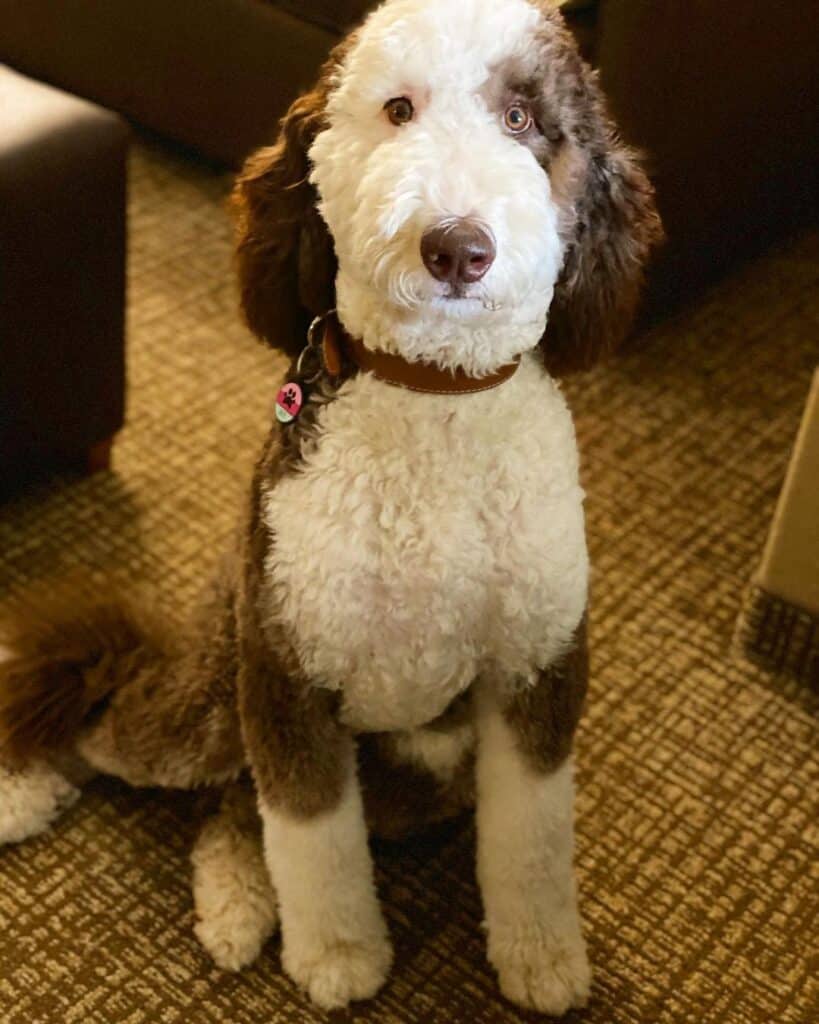
It’s suggested that bernedoodles should be groomed using a slicker brush or another type of tool which can remove any loose hairs from under the dog’s fur without matting it together–this helps reduce skin irritation and prevent infection because Bernedoogle coats tend t become matted with loose hair.
It’s important to brush your bernadoodle often so this loose dirt doesn’t get trapped under his/her coat; if left untreated, it could lead to rashes from moisture accumulating because these little guys are prone to getting hot fast when all this activity combined with being overweight.
It’s best not to use conditioner because dogs have so much natural oils already coming from their skin; this could lead to too much moisture in the dog’s coat and lead to skin problems as well.
You should always check the Dogs ears for fluid or dirt buildup, and then wipe them clean with a damp cloth or towel.
Do Bernedoodles Shed?
Bernedoodles are not considered to be a heavy shedding dog. They will have periodic blowouts where they lose lots of fur due to the fact that their coats grow continuously, but for most Bernedoodles this is usually just once or twice per year and can last about two weeks at the longest.
This means you won’t need to vacuum up piles of hair constantly if you get one!
But it’s important to remember that every animal sheds some amount–some more than others–so make sure your home has enough space allocated in order for him/her (and any other pets) so he doesn’t shed all over furniture and carpets when getting used to his new environment.
In addition, don’t forget to brush them often and clean their ears regularly – this is the best way to keep shedding at a minimum.
They will generally shed less than other breeds and they also have shorter hair which can make grooming them easier! This means that it’s more likely that their fur will be present on your furniture instead of just everywhere in the house like some other types of dogs may leave behind due to having longer coats with thicker hairs.
Are Bernedoodles Hypoallergenic?
Bernedoodles are not considered to be hypoallergenic because they still have fur. Fur is a natural source of allergens, but the level may vary from dog to dog.The only dogs that would be considered completely non-shedding and therefore “hypoallergenic” are those which do not produce any hair.
Bernedoodles may have less dander and shed less than other breeds of dogs but they still produce allergens in their saliva which can cause reactions for those who suffer from pet allergies.
“While there are no 100% hypoallergenic dogs, there are many breeds that do well with allergy sufferers. Dander, which is attached to pet hair, is what causes most pet allergies in humans and these dogs have a non-shedding coat that produces less dander.” AMERICAN KENNEL CLUB
Bernedoodles are often considered by many people as hypoallergenic because they do not shed much and their fur is less likely to contain dander.Bernedoodles produce a low allergy factor and don’t have any types of fur that may cause an allergic reaction if the dog is brushed too much.
It is very important to remember that whether or not a particular Bernedoodle is hypoallergenic or not depends on the actual genes that it inherits from its parents.
However, as a general rule of thumb, the more poodle in your bernedoodle, the higher chance it will be hypoallergenic. This is because poodles in general have low levels of shedding and are more hypoallergenic.
If you are allergic to dogs, then make sure that your bernedoodle doesn’t shed too heavily in order for him not to trigger any allergies; it’s best if the dog can be groomed often so this loose dirt doesn’t get trapped under his coat which could lead to skin problems.
Quick Tip : if you are very serious about picking out a Bernedoodle puppy that is highly hypoallergenic, go for one that is a cross between F1 B generation and F1 generation. This ensures highest probability of poodle genes in them .


Common Health Issues That Can Affect Bernedoodles
Bernedoodles are a fairly healthy breed of dog, however there are some common health issues that can affect them.Bernedoodles are a mixed breed which means they can inherit some of the health issues that both breeds have.
Poodle Faults: Hip Dysplasia, Progressive Retinal Atrophy, Cataracts and Skin Issues (e.g., allergies)
Mountain dog faults : Elbow dysplasia, Osteochondrosis dessicans, Patellar Luxation.
Detailed info :-
Bone spurs: These are caused by a growth of calcium in the dog’s joints. This can lead to inflammation or pain, and it is usually seen on their elbows and hips Of bernedoodles.
–Skin disorders: Various skin issues can arise due to genetic predisposition; these include allergies, food sensitivities, seborrhea dermatitis (a chronic condition where they have excess oil production from their skin), etc.
–Eye problems: Bernedoodles may also be at risk for eye diseases such as cataracts which could cause them to go blind without treatment!
Diabetes Mellitus Type II: Dogs with this type will show symptoms like increased thirst/urination which leads to excessive weight loss and muscle wasting over time.
Allergies :A common health issue that can affect Bernedoodles is allergies. If you notice your dog having ear infections, chronic skin irritation or other allergic reactions, make sure to take them into the vet as soon as possible! Once they are properly diagnosed and treated for this allergy then these symptoms should subside over time.
Hip dysplasia :Another thing to keep in mind is hip dysplasia; if your bernedoodle has a family history of this condition, it’s recommended that he/she be tested before adoption so there isn’t any surprises down the line.
Hip Dysplasia affects how well their hips work which leads to pain when walking on slippery surfaces like tile floors and difficult times climbing stairs–this could lead to arthritis later in life too!

Bernedoodle Training: How to Train a Bernadoodle ?
The Bernedoodle is a very intelligent, social and loving breed of dog. They are eager to please and will quickly learn what you want them to do in order to keep up with your family’s needs! So how can you train this fluffy pup? Well there are several different methods that have proven successful for many families who own Bernedoodles:
–Positive Training Methods: This type of training involves rewarding the dogs when they obey commands without using any negative consequences (like hitting or yelling).
For example, if he/she goes on command then reward him/her by giving them some treats–or spend time playing together so they know their behavior was rewarded even though it may not seem like much at first glance. You’ll be surprised how quickly they learn by playing games!
Don’t use food as a negative consequence : This could lead your dog to become overweight. If you do want to feed him/her, then make sure that he has been given proper exercise beforehand or is allowed plenty of rest afterwards.
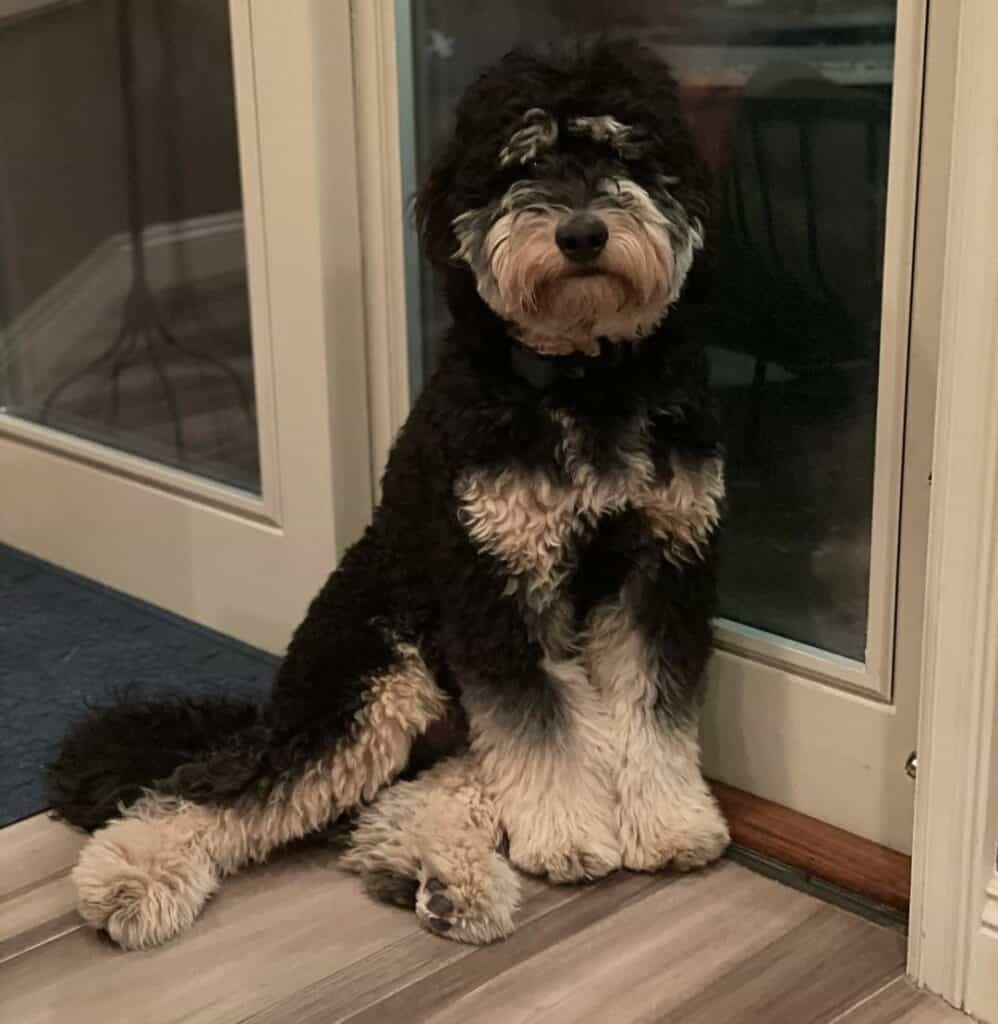
–Punishment Methods: Avoid physical punishment such as yelling, hitting or using choke chains which can cause fear and anxiety in dogs; this also goes for other types of harsh training techniques like punishers (e.g., shock collar) too!
Dogs don’t learn from being punished–they simply begin associating the pain with whatever behavior caused it at first place so their obedience will only last as long as the pain does.
–Dominance Training: Another option would be dominance training which might include techniques like alpha rolling where you place yourself on top of the dog’s back while he/she lays down (in order to show him who is boss) or “getting their attention” when they are engaging in unwanted behaviors.
Dominance training can be very effective for dogs who need a lot of structure and rules–just be sure not to use it too harshly or you might end up with an aggressive dog instead! However do keep in mind this method may be unsuitable for the tiny and mini bernedoodle varities.
–Crate Training: Another way that people have found success is by using crate training. This means confining the bernedoodle within his/her own space, so he has a safe place where they are comfortable while their family members aren’t home and they’re left alone as well as times when there are guests over (to avoid any confusion).
They will often feel more secure in this type of environment which could lead to them being less anxious around other animals or people during these situations.
–Puppy kindergarten: This type of training is great for young pups and involves learning useful skills like how to stay calm during a vet visit, heeling on leash (walking next to you instead of pulling) or walking through crowds without getting anxious.
These puppies will also be socialized with each other which could lead to them being more confident in unfamiliar situations because they know the basics when it comes to dog-dog interactions!
–Keep it short and sweet: You don’t want to make your training sessions last too long because this will only bore them which may cause their behavior problems to worsen! For instance, 30 minutes per day at most should be enough for a bernedoodle pup who is younger than six months old–any more time spent could lead him/her to become frustrated or bored.

Bernedoodles Cost : How Much Do Bernedoodles Cost ?
This is a difficult question to answer because the cost varies between breeders. For example, some bernedoodles are in high demand which means they may be more expensive than others who are not as popular.
But if you’re looking for a guideline, then it might run anywhere from $1500-$2000 for one that’s cross-bred (but has been bred with champion bloodlines). If you want a purebred Bernese Mountain Dog and Poodle mix–it could go up to $5000 or so!
You have to bear in mind that all Bernedoodles don’t have the same colour and size. There are several factors that affect the cost of a burn a total including the colour,size,generation type, breeder’s reputation, coat Texture Type etc.
But remember: these prices don’t include any of the costs associated with caring for them like food, supplies or veterinary services. So keep this in mind before making your decision!
A lot of people don’t realize how much money goes into raising a dog until after they’ve already brought one home (or even worse: adopted them). Some dogs may cost up to $2000 just for their first vet visit alone which is why I recommend doing your homework beforehand.

Bernedoodle Lifespan :What Is The Lifespan Of A Bernedoodle?
A Bernedoodle’s average life-span can range from 12 to 15 years. But just remember that this is an *average* and cannot be applied to every individual dog–some Bernedoodles can outlive their average life expectancy by quite a few years while others might die prematurely due to genetic issues or diseases.
Also keep in mind that any dog who is not properly cared for or exercised could have shorter lifespans–especially if he/she suffers some type of injury (e.g., falls, gets hit by a car) during their lifetime too!
But as long as you follow these steps and provide the proper care and attention your bernedoodle needs, they’ll live much longer than average which is always an added bonus! I think it’s so important to form this bond with our furry companions because they give us so much love in return–even though we do sometimes take them for granted at times .

Where To Find A Reputable Breeder For Bernadoodles?
Finding a reputable breeder is the first step in your decision-making process when it comes to getting a bernedoodle for yourself. The best way you can do this? Ask around!
Word of mouth has always been an effective form of advertising, so start with people who have Bernese Mountain Dogs and Poodles already–they might be able to recommend some good breeders they know or even point you towards someone’s website which may offer more information about their dogs.
Another great place where you can find reputable breeders is through local dog clubs which often host events for prospective pet owners like puppy socials, adoption days or other meetups that involve puppies (who are usually available at these types of gatherings). You could also talk to your veterinarian–they may have some recommendations or places they can point you towards.
There are also websites that give information about breeders in the US and around the world which include reviews from past customers as well as contact info for each breeder (which includes their email address, phone number, website and more).
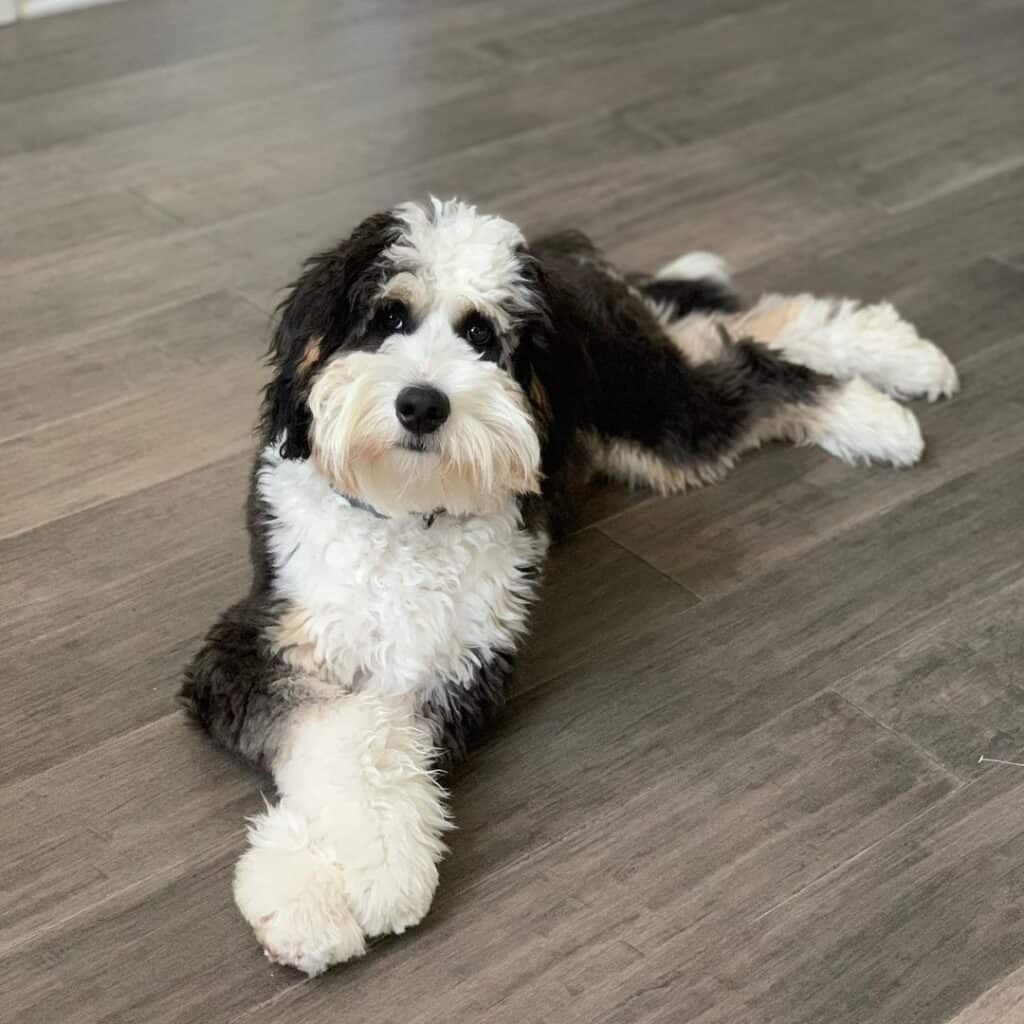
Some of these sites will let you filter by location so it’s easier to find one near where you live!
Start with a reputable breeder who is knowledgeable about bernedoodles: this will ensure that all health concerns related to their breeding process have been addressed before they’re made available for adoption.
When looking at potential breeds on a site like Petfinder, keep an eye out for any red flags such as poor reviews, complaints or other issues that may come up.
Don’t forget: a breeder can only show you the best of their stock so it’s important to do your research beforehand–don’t just assume they’re all perfect because that couldn’t be further from the truth!
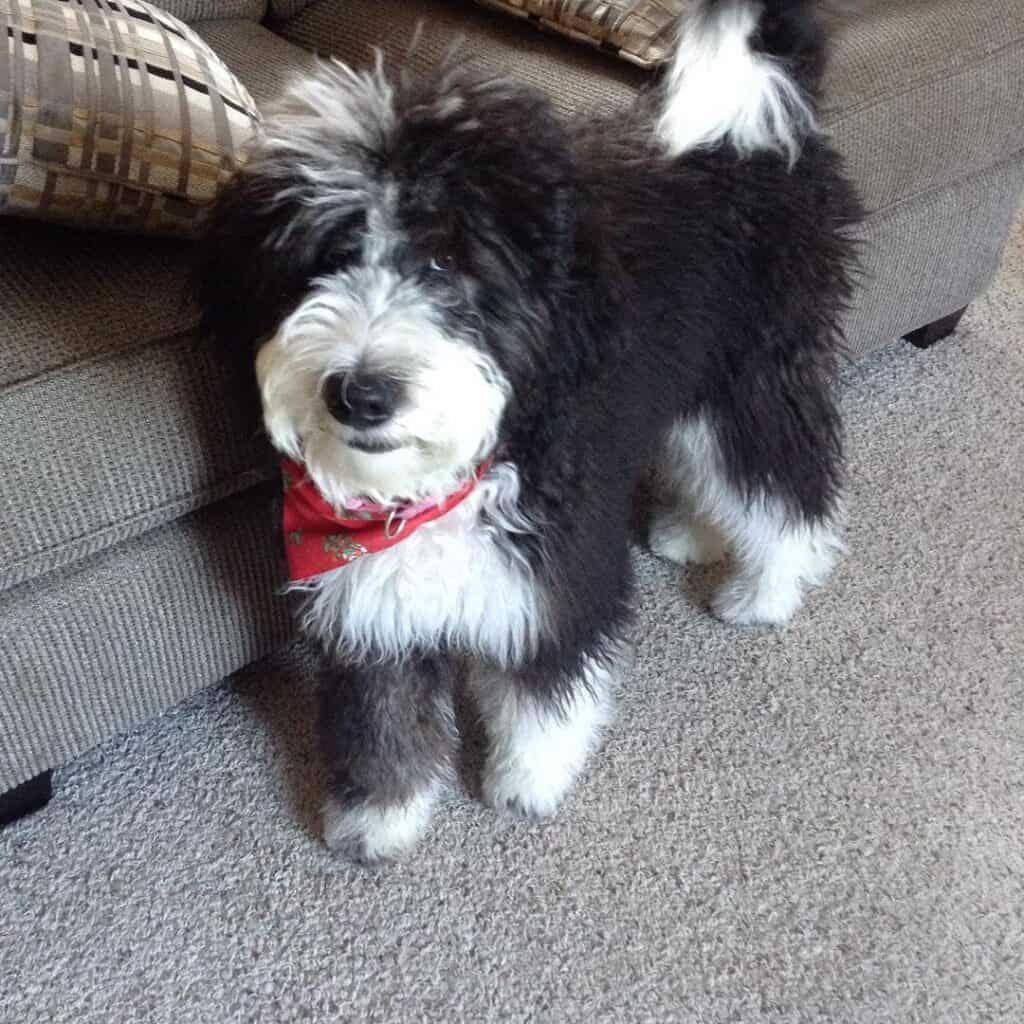
A reputable breeder will be committed to showing you the parents of your potential pup–even before they’re born! This means that these breeders are going out of their way to make sure both mom and dad have been cleared for any genetic diseases (like hip dysplasia, heart issues or eye problems) which could’ve occurred in previous generations.
If after all this research it seems like the Bernedoodle sounds perfect for your family then I recommend contacting them about meeting their dogs so you can see if there’s a good fit!
They may ask you for references or to fill out an application form before being approved as a potential owner which is done so they can make sure the pup will be going home with someone who’s committed and capable of caring for him/her. If everything goes well then congratulations–you’re on your way to having one of these cool dogs in your life!”
Another option would be looking for bernedoodle rescue groups online as well or checking with local shelters if you’re on a tight budget and want to adopt rather than buy from an unfamiliar place.
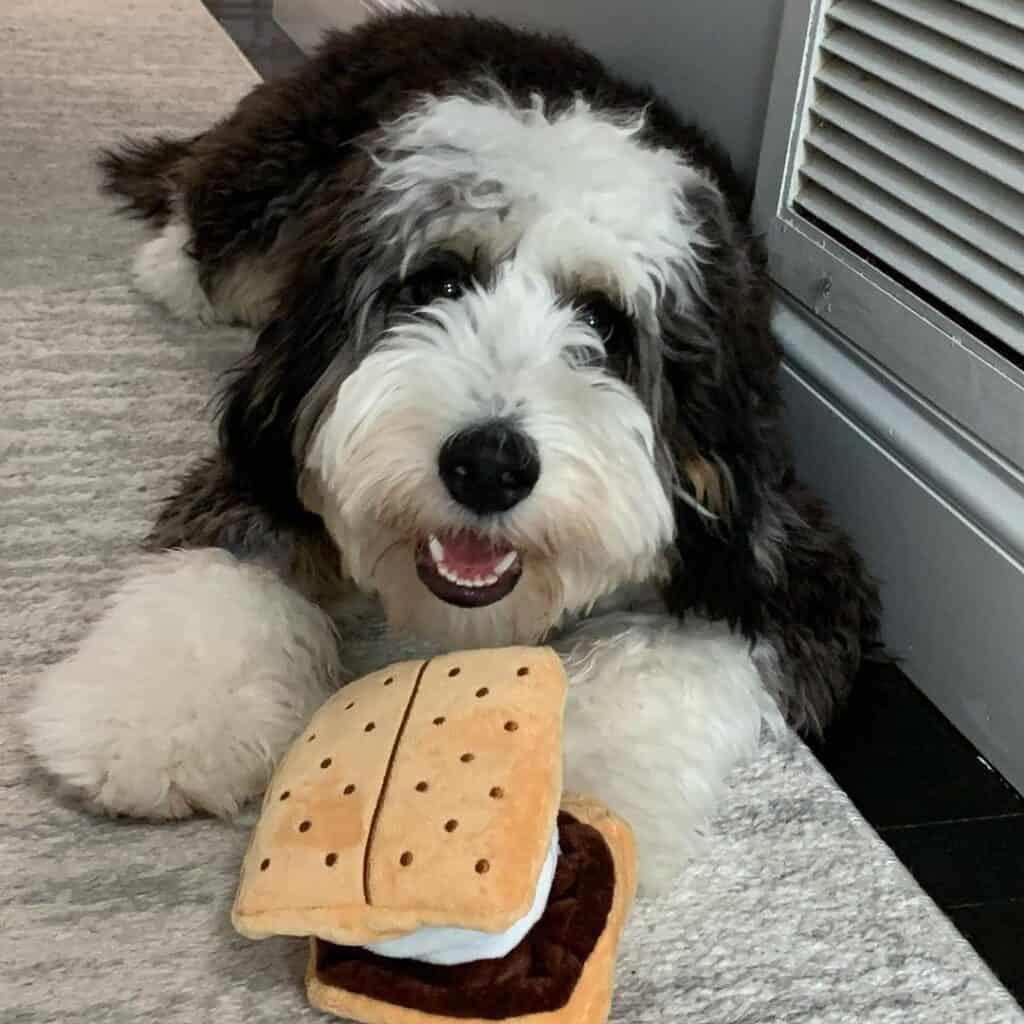
Wrapping up : If you’ve been thinking about getting a new furry friend, then this is the perfect time to do it. Bernedoodles with their floppy ears and long hair are perfect to cuddle those cold winter days away in front of the fire or curl up and nap during any season.
It’s not hard to see why this hybrid pooch has become so desirable–it combines many of the qualities people like best in both parents: intelligence without aggression; easy-going disposition with low shedding; calm personality with good energy levels for active families. Get yours today and enjoy years of cuddles with these gentle fur babies!
XoXo
Genie
RELATED QUESTIONS:
Do Bernedoodles Like To Cuddle ?
Bernedoodles are known to enjoy cuddling with their family and friends–especially when it comes to naptime. If you’re looking for a companion who will gladly curl up next to you on the couch or lay by your feet while reading, this is the perfect pup for you!
Do Bernadoodles Like The Cold ?
Bernedoodles usually don’t mind the cold–they actually seem to love it. These dogs are bred from two parents who have a tolerance for colder climates, so they’ll happily stay outside in the winter or go on walks without any problems!
Bernedoodles are known to enjoy cold weather and snow due in part to their thick fur that keeps them warm. This can make a bernie the perfect companion for those who love winter sports such as skiing, sledding or playing outside with their pup!
Can Bernedoodles Be Aggressive?
While it is possible for any dog to be aggressive, the Bernedoodle is not a breed that typically has this problem. If you are looking at getting one of these dogs as pets then rest assured–they will most likely have a mellow disposition and temperament with an easy-going attitude which makes them suitable companions for children or adults alike!
Do Bernadoodles Get Separation Anxiety ?
Bernedoodles can have separation anxiety just like any other dog, but it’s not common. These dogs are active when you’re at home with them–they love to play and will even enjoy a good tug of war game or fetching session!
However, the bernie is an intelligent breed who knows that they need their space, and they will be satisfied with spending time alone or inside the home. They may cry or whine when you leave, but it’s not as common for these dogs to have a full-blown anxiety attack like some breeds tend to do.”
One thing that could cause a bernie dog some stress is being left alone for long periods of time, so it’s best to keep them company as much as possible.
Are Bernedoodles Big Chewers?
Bernedoodles are generally not big chewers like many other dog breeds, which makes them a perfect option for most families. They’re gentle and would much rather snuggle up next to you on the couch than tear your furniture apart (although they may get into things if left unsupervised).
However, it’s possible that Bernies will chew when they are anxious or bored–especially if you leave them alone for a while. Make sure to keep their environment clean and filled with plenty of toys, bones, puzzles and other things that will help alleviate the boredom!
Are Bernadoodles Good With Cats?
Bernedoodles are typically good with cats. These dogs have a high tolerance for children, other pets and just about anything else you can throw their way–including felines!
However, it’s important to keep in mind that Bernies will chase small animals if they see them running. They may also misinterpret the cat as being aggressive or a threat, so it’s best to keep them on a leash or behind an enclosed barrier when they are around felines.
